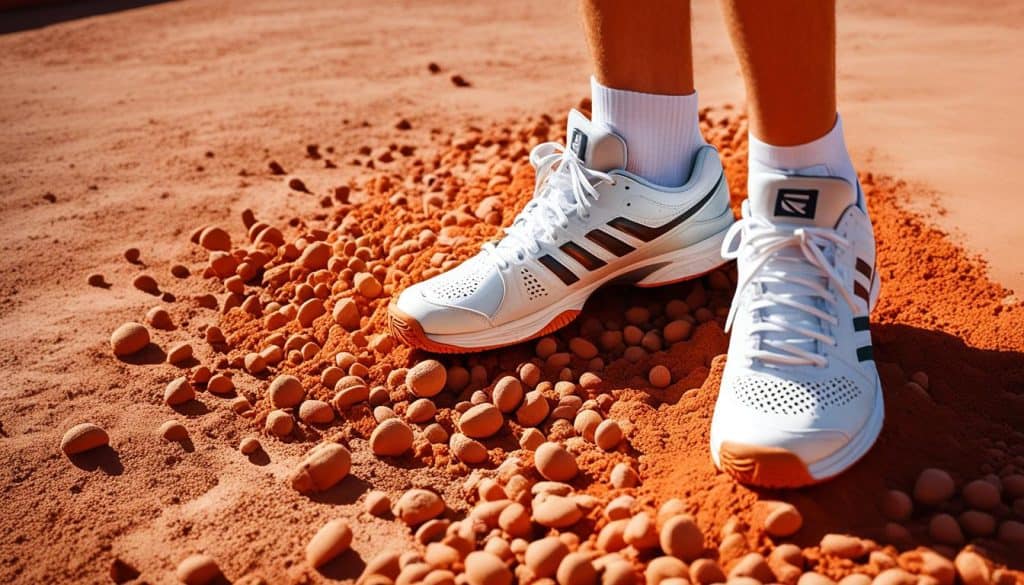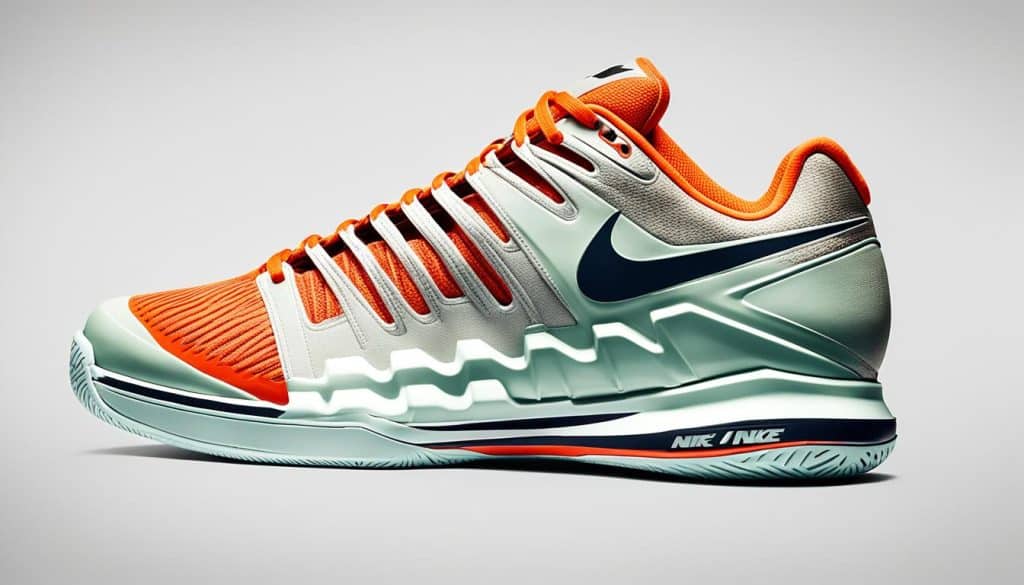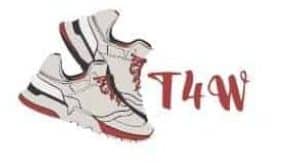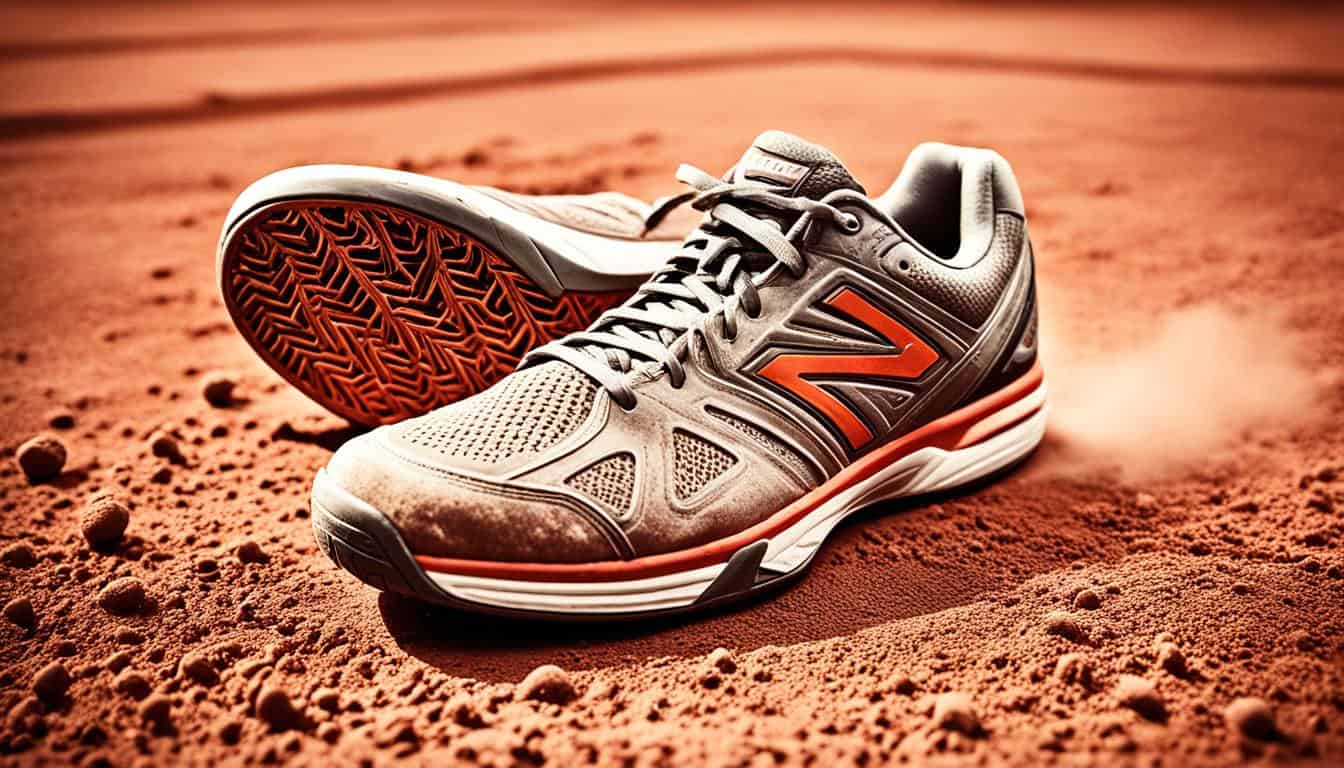Have you ever wondered how playing on clay courts can ruin your beloved tennis shoes? Are you ready to uncover the truth behind the impact of clay on your footwear? Brace yourself as we dive into the hidden secrets that reveal why clay courts can wear and damage your shoes quicker than you think.
The Abrasive Truth about Clay Courts and Your Shoes.
Clay courts can be like that mischievous pal who’s fun but leaves a mark. The fine granules on clay can act like sandpaper on your shoe soles, leading to quicker wear and tear. We’ll explore the abrasive nature of clay courts and its impact on your shoes.
Playing on clay courts introduces a unique set of challenges for your tennis shoes. While the soft and forgiving surface offers a slower game pace and reduces impact on your joints, it can be quite unforgiving on your footwear. The fine granules of clay can gradually wear down the soles of your shoes, much like sandpaper on wood.
Imagine every slide, pivot, and quick movement gradually eroding the rubber beneath your feet. With each match, your shoes inch closer to becoming worn-out victims of the clay court’s mischievous quality.
Unlike other court surfaces, clay courts don’t provide a smooth and frictionless environment. The clay particles latch onto the grooves of your shoe’s outsole and become embedded over time, exposing the rubber to additional friction and accelerating the wear and tear process.
“The clay court may be your playground, but your shoes bear the brunt of its mischievousness. Fortunately, there are steps you can take to protect your beloved sneakers and prolong their lifespan on clay.”
To combat the abrasive effects of clay courts, it’s important to choose tennis shoes specifically designed for this challenging surface. Brands like Adidas and Nike offer clay court tennis shoes with enhanced durability and traction, minimizing the wear and tear caused by the fine granules.
Understanding the Impact of Clay on Your Shoes
Before delving into the protective measures, it’s essential to understand how clay courts affect your shoes. The fine granules of clay act like sandpaper, slowly eroding the rubber soles. This abrasion not only affects the traction and grip of your shoes on the court but can also lead to visible signs of wear and tear.
With prolonged exposure to clay courts, you may notice your shoe soles becoming smooth and losing their original texture. The once prominent grooves that offered optimal traction diminish, posing a challenge to your stability during plays and maneuvers.
Moreover, the tiny clay particles embedded in the shoe’s outsole can cause an uneven distribution of pressure, leading to premature breakdown of the shoe’s materials. This can result in decreased support and cushioning, heightening the risk of discomfort or even injury.
It’s crucial to address the abrasive nature of clay courts early on to ensure your tennis shoes withstand the rigors and challenges of this unique playing surface.
Stay tuned for Section 3 where we will shed light on specific tennis shoe models designed to excel on clay courts.
Product Spotlight: Adidas Barricade Tennis Shoes for Clay Courts.
If you’re a clay court enthusiast, you know that finding the right tennis shoes can make all the difference in your game. That’s where the Adidas Barricade tennis shoes come in. Designed specifically for clay courts, these shoes offer a winning combination of durability and enhanced traction to help you glide across the court with confidence.
When it comes to durability, Adidas Barricade tennis shoes are built to withstand the rigors of clay courts. The tough outsole and reinforced upper ensure that these shoes can stand up to the demands of your game, delivering long-lasting performance and protecting against premature wear.
But durability is just one part of the equation. Adidas Barricade tennis shoes also excel in traction, giving you the grip you need to move swiftly on clay surfaces.
The shoes feature an innovative outsole pattern that helps enhance traction and grip on the court, allowing you to make those quick turns and agile movements without slipping.
By minimizing wear and tear on the shoes, the enhanced traction of Adidas Barricade tennis shoes not only keeps you more stable during gameplay but also ensures a longer lifespan for your footwear investment.
In addition to durability and enhanced traction, Adidas Barricade tennis shoes offer other features that cater to the unique demands of clay court playing. The shoes provide excellent lateral support, stability, and cushioning, helping you stay comfortable and confident throughout your matches.
Product Highlights:
- Durable construction to withstand the rigors of clay courts
- Enhanced traction for exceptional grip and maneuverability
- Excellent lateral support and stability
- Responsive cushioning for added comfort
“Adidas Barricade tennis shoes are a game-changer for clay court players. The combination of durability and enhanced traction gives you the confidence to perform at your best and minimize wear and tear on your shoes. With these shoes, you’ll be unstoppable on the court!” – Maria Martinez, professional tennis player
Investing in a pair of Adidas Barricade tennis shoes for clay courts can elevate your game to new heights. Their durability, enhanced traction, and overall performance make them a top choice for tennis enthusiasts who want to excel on clay surfaces.
The Secret Life of Clay on Your Shoes: It’s Not Just Dirt!
Clay on your shoes is more than just dirt. Think of clay as the glitter of the tennis world; it gets everywhere and sticks stubbornly. This sticky nature can lead to uneven wear, especially if not cleaned properly.
When you step onto a clay court, your shoes become magnets for clay particles. These tiny granules latch onto the soles, creating a layer that affects your shoe’s performance and lifespan. As you move, the clay can get embedded in the treads and crevices, forming a sticky coating that alters traction and causes uneven wear.

“Clay can be like a mischievous friend that sneaks up on you and wreaks havoc on your shoes. So, it’s crucial to understand the secrets of clay and take proper care of your footwear.”
Proper cleaning is essential to combat the secret life of clay on your shoes. By removing the stubborn clay residue, you can prevent uneven wear and ensure that your shoes maintain their optimal performance on clay courts.
Importance of Proper Cleaning
When clay particles stick to your shoes, they can create an abrasive surface that interacts with the court, increasing friction and compromising your shoe’s traction. The stickiness of clay also attracts dirt and other debris, further impacting your shoe’s performance.
To keep your shoes in prime condition, here are some essential cleaning tips:
- Immediately after playing on clay, remove as much clay as possible using a brush or cloth.
- For stubborn residue, gently scrub the soles with a soft bristle brush and mild soapy water.
- Rinse your shoes with clean water to remove any soapy residue.
- Allow your shoes to air dry naturally, avoiding direct heat sources that can cause shrinkage or damage the materials.
- Periodically deep clean your shoes using specialized shoe cleaning products to remove any lingering clay or stains.
By following these cleaning practices, you can extend the lifespan of your shoes and ensure they remain in optimal condition, allowing you to focus on dominating the clay court.
| Benefits of Proper Cleaning | Consequences of Neglect |
|---|---|
|
|
Surprise Benefit: Improved Traction, but at What Cost?
Playing on clay courts can have a surprising benefit for your tennis shoes – improved traction. As you navigate the clay courts, the fine clay particles work their way into the tread of your shoes, creating a smoother and more gripping surface.
This unexpected advantage can give you an edge on the court, enhancing your ability to make quick movements and maintain stability.
The clay that fills in the tread of your shoes acts as a natural adhesive, increasing the friction between your shoes and the court.
This improved traction can help you stay on your feet, prevent sliding, and execute swift changes in direction. It provides a level of control that is particularly advantageous on clay courts, which are known for their slippery nature.
However, with this surprise benefit comes a potential trade-off. While the improved traction can enhance your performance on the court, the clay particles that get trapped in the tread can also accelerate the wear and tear on your shoes. Over time, the abrasive nature of the clay can cause the sole of your shoes to deteriorate more quickly.
Remember, it’s essential to strike a balance between optimizing your shoe’s traction and ensuring its longevity.
To mitigate the potential downside, regular cleaning and maintenance are crucial. Removing excess clay from your shoes after each session and thoroughly cleaning them afterward can help prolong their lifespan.
Investing in tennis shoes specifically designed for clay courts can provide additional durability and protection against accelerated wear.
By understanding the mechanics behind the improved traction on clay courts and taking proper care of your shoes, you can reap the benefits of this surprise advantage without compromising their longevity. It’s all about finding the right balance and ensuring that your shoes are ready to perform, match after match.
Product Recommendation: Nike Zoom Vapor X Clay Tennis Shoes.
If you’re a tennis player looking for the perfect pair of shoes to dominate on the clay courts, we have a product recommendation for you – the Nike Zoom Vapor X Clay Tennis Shoes. Designed with the unique needs of clay court players in mind, these shoes offer exceptional performance and durability.
One of the standout features of the Nike Zoom Vapor X Clay Tennis Shoes is the specialized outsole pattern optimized for clay courts.
This pattern provides superior traction on clay surfaces, allowing you to make quick, agile movements without worrying about slipping or sliding. The innovative design ensures that you can focus on your game and give it your all.
Not only does the outsole pattern provide excellent traction, but it also contributes to the longevity of the shoes. The optimized design minimizes wear on the outsole, allowing you to enjoy these shoes for an extended period.
You can count on the Nike Zoom Vapor X Clay Tennis Shoes to withstand the demands of intense matches and training sessions on clay courts.
With the Nike Zoom Vapor X Clay Tennis Shoes, you don’t have to sacrifice comfort for performance. These shoes feature a cushioned midsole that provides responsive cushioning and absorbs impact, making every step on the court comfortable and supportive. You can focus on your game without any distractions or discomfort.
Additionally, the Nike Zoom Vapor X Clay Tennis Shoes are crafted using high-quality materials that offer durability and breathability. Your feet will stay cool and fresh even during long matches, thanks to the superior ventilation provided by the shoe’s construction. Say goodbye to sweaty and uncomfortable feet!
“The Nike Zoom Vapor X Clay Tennis Shoes are a game-changer for clay court players. The optimized outsole pattern and longevity of these shoes make them a top choice for anyone serious about their game.” – Professional Tennis Player
Don’t let inadequate footwear hold you back on the clay courts. Invest in a pair of Nike Zoom Vapor X Clay Tennis Shoes and experience the difference they can make in your game. No matter your level of play, these shoes are designed to meet the demands of clay court tennis.
So, lace up your Nike Zoom Vapor X Clay Tennis Shoes and step onto the clay court with confidence. Unlock your full potential and leave your opponents in awe of your performance. Get ready to elevate your game to new heights with these exceptional clay court tennis shoes.

The Hidden Enemy: Moisture Absorption in Clay Courts.
Clay courts may seem like a dreamy surface to play on, but they have a hidden enemy that can wreak havoc on your tennis shoes – moisture absorption. Clay, like a sponge, has a remarkable ability to absorb moisture, which can seep into your shoes during a match.
This absorption process poses potential odor issues and can even lead to a breakdown of materials over time.
Imagine your tennis shoes as the target, and clay as the mischievous infiltrator, seeping in and causing damage from within. If not addressed, this hidden enemy can compromise the integrity and longevity of your favorite kicks. But fear not, there are ways to combat the moisture absorption and protect your shoes.
The Clay Court Challenge: Clay as a Sponge
Clay courts, known for their distinctive red surface, are made up of fine granules that make them ideal for sliding and superior playability. However, these same granules act like a sponge, readily absorbing any moisture on the court.
“Clay courts, with their moisture-absorbing properties, can turn your shoes from odor-free to odorous and pristine to deteriorating, if proper precautions aren’t taken,” explains tennis shoe expert, Rachel Thompson.
When playing on clay, particularly in humid conditions or after rainfall, the court can become saturated with moisture. As you move around and make contact with the surface, the clay granules attach to the outsoles of your shoes.
Over time, the clay granules slowly seep into the shoes, creating a damp environment that promotes odor development and weakens the materials.
Preventing Moisture Absorption: Tips and Tricks
To combat the hidden enemy of moisture absorption in clay courts, take these proactive steps to protect your tennis shoes:
- Choose the Right Socks: Opt for moisture-wicking socks with adequate ventilation. These will help keep your feet dry and reduce the amount of moisture that can seep into your shoes.
- Invest in Breathable Shoes: Look for tennis shoes specifically designed for clay courts with excellent ventilation. These shoes often feature perforations or mesh panels that allow for proper airflow, preventing excessive moisture buildup.
- Keep Your Shoes Clean: Regularly clean your shoes after playing on clay. Removing any residual clay helps prevent further absorption and minimizes odor development.
By following these tips and being proactive in combating moisture absorption, you can prolong the lifespan of your tennis shoes and keep them in optimal condition for longer.
Next, we’ll explore the importance of post-match care and delve into the steps you can take to ensure your tennis shoes remain in prime condition, even after intense clay court battles.
Long-Term Love: Caring for Your Shoes Post-Match.
Post-match care is crucial for maintaining the longevity of your tennis shoes. By properly caring for your shoes, you can prevent long-term damage and keep your beloved sneakers in top condition for a long time. Here are some essential tips for caring for your shoes after a game:
Removing Clay
The clay on tennis courts can be stubborn and cling to the soles and uppers of your shoes. It’s important to remove the clay promptly to prevent it from causing any damage.
Use a soft brush or cloth to gently remove the clay from all parts of your shoes, paying particular attention to the tread and the areas where clay tends to gather. Remember to clean the laces and any other removable parts as well.
Drying Shoes
After removing the clay, it’s crucial to dry your shoes thoroughly. Excessive moisture can lead to mold, mildew, and unpleasant odors. Start by using a clean cloth to wipe off any excess moisture on the surface of the shoes.
Then, place them in a well-ventilated area away from direct sunlight or heat sources. To speed up the drying process, you can stuff your shoes with newspaper or use a shoe dryer if you have one. Avoid using a hairdryer or placing them in the dryer, as this can damage the materials.
Preventing Long-Term Damage
To ensure that your shoes remain in excellent condition in the long run, it’s essential to take preventive measures. Consider the following tips:
- Use a protective spray or waterproofing agent on your shoes to create a barrier against moisture and stains.
- Alternate between multiple pairs of shoes to allow them to dry completely between uses.
- Avoid wearing your tennis shoes for activities other than playing tennis, as this can lead to unnecessary wear and tear.
- Store your shoes in a clean and dry location, away from extreme temperatures and humidity.
- Regularly inspect your shoes for any signs of damage or excessive wear. Promptly address any issues to prevent further deterioration.
By following these post-match care tips and taking preventive measures, you can show your shoes the long-term love they deserve and enjoy extended use out of your favorite pair.
Remember that proper care and maintenance are the keys to keeping your shoes in top shape and ready for your next match.
Maintenance Must-Have: Invest in a Good Shoe Care Kit.
To keep your clay court shoes in prime condition, it’s essential to invest in a good shoe care kit. One highly recommended option is the Jason Markk essential kit. This comprehensive kit includes a gentle cleaner and brush, perfect for maintaining the longevity and cleanliness of your shoes.
Using the gentle cleaner from the Jason Markk essential kit ensures that you can effectively remove dirt, stains, and debris without causing any damage to the shoe’s material. The gentle formula is specifically designed to be safe for use on a variety of materials, including those commonly found in clay court shoes.
The brush included in the kit is designed to be both effective and gentle. Its soft bristles allow for thorough cleaning without scratching or damaging the shoe’s surface. With this brush, you can easily remove dirt and clay particles from hard-to-reach areas, ensuring that your shoes remain in prime condition.
Investing in a shoe care kit like the Jason Markk essential kit will not only help you maintain the appearance of your clay court shoes but also extend their lifespan.
By regularly cleaning and caring for your shoes using the kit’s gentle cleaner and brush, you can ensure that your shoes stay in optimal condition, providing you with the performance and support you need on the court.


